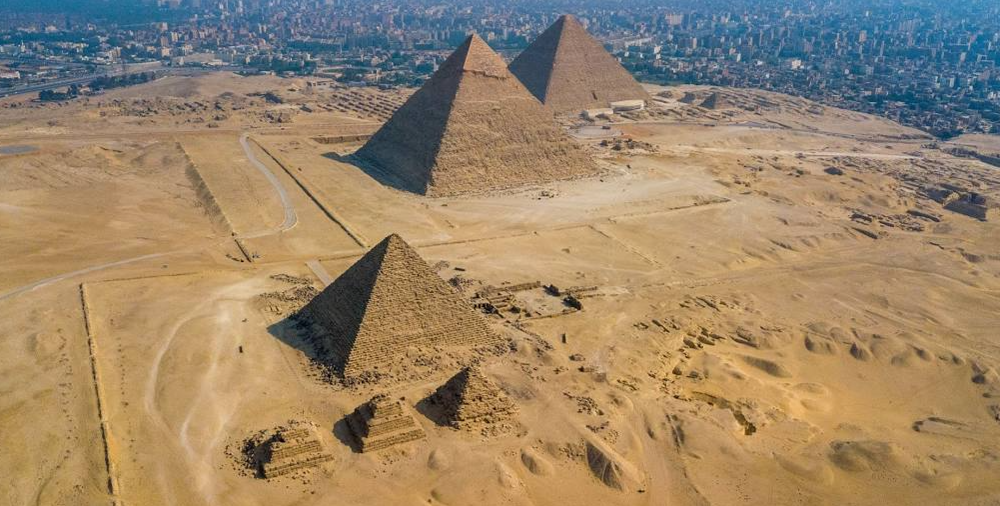Pyramids of Giza and Great Sphinx
Introduction
Time challenges humankind, but the pyramids defy time and place. They are as eternal as time and space itself. The engineer of the Great Pyramid, Hemiunu, famously stated, “I built the pyramid in 20 years. Try to demolish it in 600 years if you can, and you will not be able to, although demolition is easier than construction.” This statement reflects the immense confidence of the ancient Egyptian creator. Time has proven his words to be true. More than 4000 years later, during the reign of Muhammad Ali (1805-1849), there was a failed attempt to demolish the pyramid in order to use its stones for the construction of the “Kantara al-Khayria”.
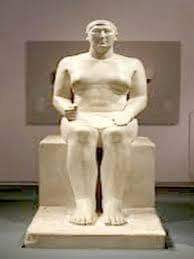 Statue of Hemiunu, the architect of the Great Pyramid
Statue of Hemiunu, the architect of the Great Pyramid
The Great Pyramid of Giza (Khufu’s Pyramid): One of the Seven Wonders of the World
This pyramid has captivated visitors and historians alike throughout the ages. It has become intertwined with numerous myths and fascinating facts. Some have claimed that it was built by Genies (super-power creatures), others by people from the lost city of Atlantis, and still others by aliens or giants. However, the truth is that this marvel was achieved by the hands of the Egyptians themselves. The construction of King Khufu’s pyramid followed the building of several other pyramids, such as those of his father, King Snefru, in Dahshur. Inscriptions found in Wadi al-Jarf (a port on the Red Sea) indicate that Meirer, the chief overseer of the pyramid’s construction, was responsible for bringing stones from the wadi to clad the pyramid. A worker’s city was discovered near the pyramid, containing the remains of bakeries and animal bones, proving that the workers were well-fed during their labor. This refutes the notion that the pyramid was built through forced labor.
Reasons for Building the Pyramid
The construction of the pyramids was driven by economic, religious, and political factors. Egyptians built these tombs for their kings, seeking to please their gods and provide food for their families.
Remarkable Properties of the Great Pyramid
One of the most fascinating aspects of the Great Pyramid is its ability to enhance various substances. For example:
• The pyramid’s shape can polish jewelry.
• It can purify contaminated water after being placed inside for several days.
• Washing one’s face with water that has been placed inside the pyramid can restore skin’s vitality and reduce wrinkles.
• Spending time inside the pyramid can promote relaxation and alleviate stress.
• Milk and meat do not spoil inside the pyramid.
• Razor blades become sharper when placed inside.
These observations have increased the world’s fascination with the pyramids and the ingenuity of the ancient Egyptians.
The Concept Behind the Pyramid
Ancient Egyptians believed that the universe began with primordial waters (Nun). When these waters receded, the world emerged. The first solid object to appear was a pyramid-shaped stone called Benben, symbolizing the rising sun. This belief influenced the Egyptians to adopt the pyramid shape for their tombs starting from the reign of King Djoser during the Third Dynasty. The pyramids were clad with smooth stones to protect them and give them a stunning appearance.
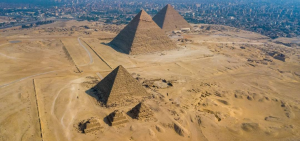 The Pyramids of Giza
The Pyramids of Giza
Naming the Pyramid
The pyramid was named “Akhet Khufu,” which translates to “Horizon of Khufu.” This name reflects the pyramid’s design and its astronomical connections. The ancient Egyptians believed in the immortality of the soul, and they envisioned the soul’s journey after death as a passage through the horizon, similar to the sun’s daily journey.
The Pyramid’s Entrance
Many attempts have been made to create openings in the pyramid, with the most recent being the one made by Caliph al-Ma’mun in 820 AD. In 1798, Napoleon Bonaparte and his French forces conquered Cairo and uncovered many of the secrets of the Great Pyramid of Khufu.
Fun Facts and Wonders of the Pyramid
Every visitor to the pyramid takes photos, but when Princess Diana visited Egypt in 1992, she initially refused to be photographed. A British photographer persuaded her by saying, “The pyramids are one of the Seven Wonders of the World, and you are the eighth. How can you refuse to be photographed with them?” She smiled and agreed, saying, “Take as many pictures as you like.”
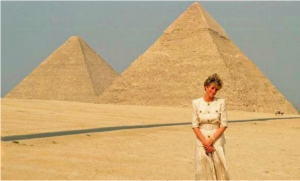 Princess Diana inf visiting the Pyramid
Princess Diana inf visiting the Pyramid
Many people have attempted to climb the pyramid or write their names on it in a quest for immortality and fame. However, in October 2024, a small dog stole the spotlight by chasing birds and climbing to the top of the pyramid. An Italian photographer captured this moment with a drone, and the image of the dog (which bears a resemblance to Anubis) quickly went viral. The British newspaper, The Times, even dubbed the dog ‘Man of the Year’.”
 Man of the Year (dog on the top of pyramid)
Man of the Year (dog on the top of pyramid)
Description of the Pyramid
The Great Pyramid was constructed from limestone blocks. Originally reaching a height of 148 meters, erosion has reduced it to 136 meters. It was once covered in a smooth layer of limestone, giving it a polished appearance that reflected sunlight during the day and moonlight at night. Today, only the inner core of the pyramid remains visible. Composed of approximately 3 million stone blocks, each weighing between 1 and 15 tons, the pyramid is an engineering marvel. The original entrance was located at a height of 20 meters but is no longer used. The current entrance, dating back to the era of Caliph al-Ma’mun, leads to a descending passage that connects to the first burial chamber, which is hewn out of solid rock. A subsequent passage leads to the second burial chamber, commonly known as the Queen’s Chamber. While empty, it is notable for its corbelled ceiling. From the Grand Gallery, one reaches the third burial chamber, constructed of granite with a ceiling comprising nine granite slabs, each weighing approximately 70 tons. On the western side of this chamber lies an empty granite sarcophagus without any inscriptions. No inscriptions bearing the name of King Khufu have been found inside the pyramid, except for a single inscription carved by a worker in the burial chamber.
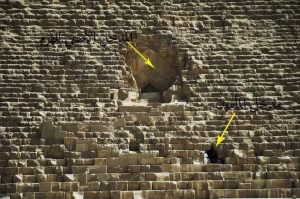 A picture showing the original entrance to the pyramid and the entrance of Al-Ma’mun
A picture showing the original entrance to the pyramid and the entrance of Al-Ma’mun
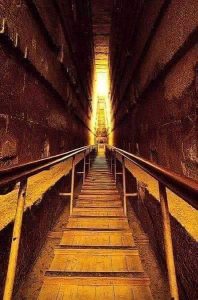 The descending corridor leading to the burial chambers
The descending corridor leading to the burial chambers
Methods of Pyramid Construction
There have been various theories about how the pyramids were built, but the most widely accepted method is based on what is known about ancient Egyptian construction techniques as below: It is believed that ramps were used to transport the massive stone blocks to the desired level of the pyramid. These blocks were placed on cylindrical wooden rollers and pulled by oxen until they reached the ramp. As the pyramid grew, workers would fill in the area around the structure with earth or rubble to create a ramp, and then remove this material once the level was completed. The pyramid was then clad with casing stones from the top down. Finally, the ramps were dismantled. It is estimated that around 100,000 people worked on the construction of the pyramid, with shifts of three months. The entire construction process is believed to have taken approximately 20 years.
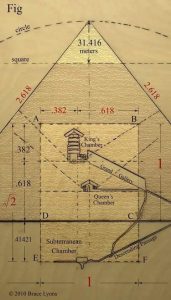 Architectural layout of the pyramid from the inside
Architectural layout of the pyramid from the inside
Despite the grandeur of the pyramid’s construction, no significant statue of King Khufu has been found within it. The only known statue of him is a small, 7-centimeter figurine from a much later period, discovered in Abydos. Completing Khufu’s pyramid complex are four smaller pyramids, intended for queens, as well as a valley temple and a mortuary temple.
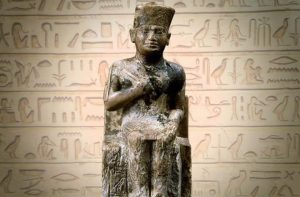 statue of King Khufu
statue of King Khufu
Khufu Solar Boat Museum
The Khufu Solar Boat Museum is dedicated to showcasing the solar boat of King Khufu, which was discovered in 1954 by engineer Kamal el-Mallah. Two pits containing Khufu’s boats, referred to as “solar boats,” were found to the south of the Great Pyramid. The first boat, constructed from cedar wood, was discovered in pieces, numbering around 1,224 individual components, and measuring approximately 43 meters in length. The museum was built in 1985 and is located just a few meters away from the Great Pyramid. It is equipped with state-of-the-art technology to preserve this ancient artifact.
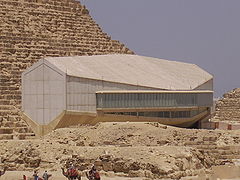 Khufu Solar Boat Museum
Khufu Solar Boat Museum

Pyramid of Khafre
Built by King Khafre, the son of King Khufu, the Pyramid of Khafre was designed to be the second tallest of the Giza pyramids. Due to its strategic location on higher ground, it appears to be taller than the Pyramid of Khufu when viewed from a distance. The pyramid is often referred to as “Wer Khafre,” meaning “the great pyramid of Khafre.”
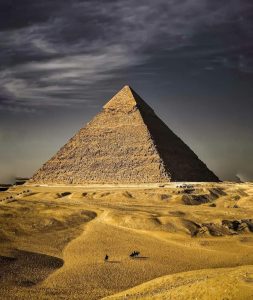 Pyramid of Khafre
Pyramid of Khafre
Description of the Pyramid
The pyramid was originally covered in a casing of smooth white limestone, remnants of which can still be seen today. It stands at a height of approximately 132 meters and has two known entrances. The first entrance is located 11 meters above ground level, while the second is cut into the solid rock. Both entrances lead to passageways that eventually terminate in the burial chamber. These entrances remained hidden beneath the sand until 1818 when the explorer Giovanni Belzoni successfully discovered the pyramid’s entrance. He explored the passageways and reached the burial chamber, where he inscribed his name and the date of his discovery. Completing the pyramid complex of Khafre are the mortuary temple, the Great Sphinx, and the valley temple, which was constructed of granite. Inside the valley temple, a diorite statue of King Khafre was discovered.
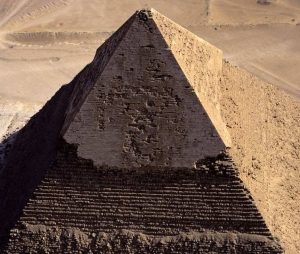 Remnants of the covering of King Khafre’s pyramid
Remnants of the covering of King Khafre’s pyramid
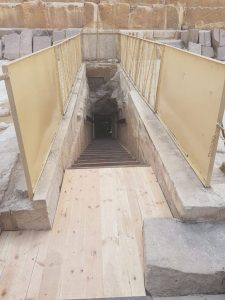 Entrance to Khafre’s pyramid
Entrance to Khafre’s pyramid
 A statue of King Khafre made of diorite is located in the Egyptian Museum
A statue of King Khafre made of diorite is located in the Egyptian Museum
The Great Sphinx: Guardian of the Ancestors
The ancient Egyptians often depicted their pharaohs as lions, a symbol of power and strength. Over time, this representation evolved into the iconic image of a human-headed lion, as seen in statues. King Khafre commissioned the Great Sphinx, naming it Hor Em Akhet, which means “Horus on the Horizon.” By placing this monumental statue in front of his pyramid, Khafre intended for it to serve as a guardian of the afterlife. The Sphinx’s likeness to the pharaoh allowed it to also represent Khafre himself, making it the guardian of the entire necropolis. The Greeks called the statue the Sphinx, while the Arabs named it Abu al-Hol. Measuring approximately 73.5 meters long and 20 meters high, the Sphinx was originally covered in a layer of colored plaster. Over the millennia, it has become gradually buried by sand. The Sphinx’s beard has been lost in pieces over time, now housed in the Egyptian Museum and some pieces in the British Museum. The missing pieces are insufficient to reconstruct the beard. It is believed that the beard was lost due to natural erosion.
The Broken Nose
There are several theories about how the Sphinx lost its nose. Some attribute the damage to natural erosion, while the most widely accepted theory suggests that it was intentionally broken by French soldiers during the Battle of the Pyramids in 1798. The Egyptians, hiding behind the sand-covered statue, were firing at the French troops, and it is believed that a cannonball struck the nose.
Legends and Mysteries
One persistent legend claims that there are hidden chambers beneath the Sphinx leading to an ancient, lost city. However, numerous excavations and investigations have failed to uncover any such chambers. Archaeologists have discovered passages beneath the statue, but these appear to have been used for storage or ritual purposes.
The Dream Stela
During the New Kingdom, approximately a thousand years after the construction of the Sphinx, Prince Thutmose IV, son of King Amenhotep II, went hunting near the monument. The Sphinx was almost entirely buried in sand, with only its head visible. The prince sat in the shade of the Sphinx’s head to rest and eat. As he slept, he had a dream in which the Sphinx spoke to him, promising him the throne of Egypt and asking him to clear the sand from its body. Upon becoming pharaoh, Thutmose IV ordered the removal of the sand from the Sphinx and had a wall built around it to prevent it from being reburied. He then erected a stela, or stone slab, between the Sphinx’s paws, on which he recorded this dream. This stela is known as the Dream Stela.
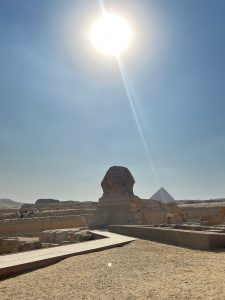 the Sphinx
the Sphinx
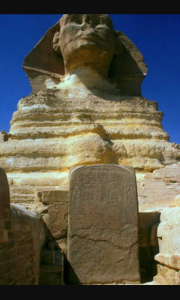 The dream stela erected by Tuthmosis IV between the feet of the Sphinx
The dream stela erected by Tuthmosis IV between the feet of the Sphinx
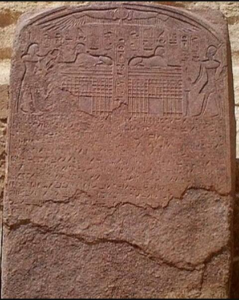 The Dream Stela
The Dream Stela
The Pyramid of Menkaure
Built by King Menkaure, the son of Khafre and grandson of Khufu, the Pyramid of Menkaure is the smallest of the three great pyramids at Giza. It stands at a height of approximately 66 meters, about half the height of his father’s pyramid.
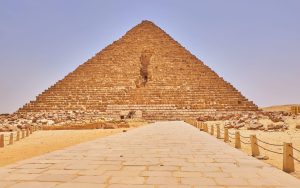 The Pyramid of Menkaure
The Pyramid of Menkaure
Description of the Pyramid
King Menkaure passed away before the completion of his pyramid complex, and the task was finished by his son, ShepSkaf. He completed the covering of the pyramid. Due to this, the pyramid’s casing was completed using two types of stone: limestone and granite from Aswan. The entrance is located on the northern side, about 4 meters above ground level. It leads to a descending passage that opens into a corridor lined with stone and eventually to the burial chamber. The pyramid complex of Menkaure includes three smaller pyramids, intended for queens, each accompanied by a small mortuary temple. The valley temple associated with Menkaure has yielded numerous statues and reliefs depicting the king, both as a solitary figure and in groups. These works showcase the remarkable skill of ancient Egyptian sculptors.
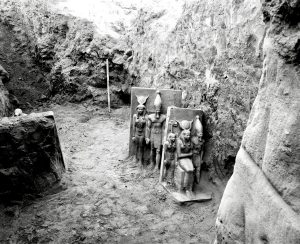 Picture of the discovery of statues of King Menkaure
Picture of the discovery of statues of King Menkaure
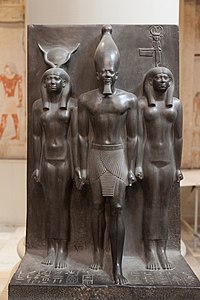 A triptych of King Menkaure with the goddess Hathor
A triptych of King Menkaure with the goddess Hathor

